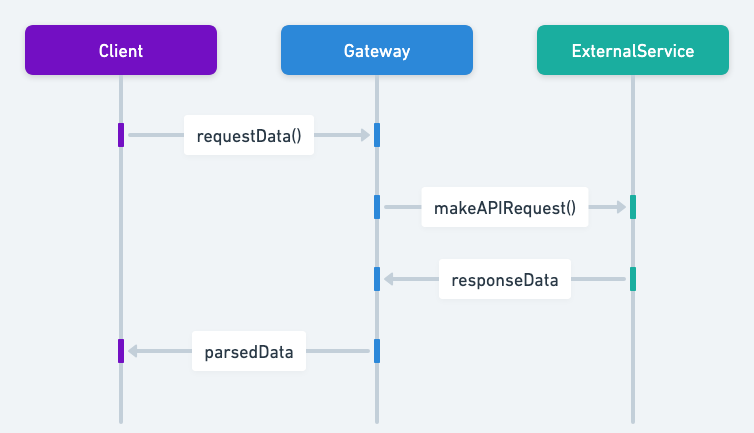Gateway Pattern in Java: Simplifying External System Integration
Also known as
- Service Gateway
Intent of Gateway Design Pattern
The Gateway design pattern is a crucial concept in Java design patterns for simplifying API integration and interactions with remote services. It provides a unified and simplified interface to external systems, enhancing the maintainability and architecture of applications. By encapsulating these interactions, the Gateway pattern ensures loose coupling and promotes a more modular and scalable software design, making it essential for robust and efficient application development.
Detailed Explanation of Gateway Pattern with Real-World Examples
Real-world example
In real-world applications, companies often need to interact with multiple external systems. The Gateway design pattern provides a unified interface for such interactions, handling protocol translation and data transformation, thereby ensuring loose coupling between the internal and external components. '
Consider a logistics company that uses multiple third-party services for various operations, such as shipping, inventory management, and customer notifications. Each of these services has its own API with different protocols and data formats. To simplify the interaction, the company implements a Gateway design pattern. This gateway acts as a unified interface for all third-party service interactions, allowing the company's internal systems to communicate with these services seamlessly. The gateway handles the translation of protocols, data transformation, and routing of requests, ensuring that the internal systems remain decoupled from the specifics of each external service. This setup improves maintainability and scalability while providing a single point of control for external communications.
In plain words
Gateway can provide an interface which lets internal system to utilize external service.
Wikipedia says
A server that acts as an API front-end, receives API requests, enforces throttling and security policies, passes requests to the back-end service and then passes the response back to the requester.
Sequence diagram

Programmatic Example of Gateway Pattern in Java
First, we define a Gateway interface. This interface represents the contract for our external services. Each service that we want to interact with will implement this interface.
public interface Gateway {
void execute();
}Next, we create our external services. These are the services that our application needs to interact with. Each service implements the Gateway interface and provides its own implementation of the execute method.
public class ExternalServiceA implements Gateway {
@Override
public void execute() {
// Implementation for ExternalServiceA
}
}public class ExternalServiceB implements Gateway {
@Override
public void execute() {
// Implementation for ExternalServiceB
}
}public class ExternalServiceC implements Gateway {
@Override
public void execute() {
// Implementation for ExternalServiceC
}
}We then create a GatewayFactory class. This class maintains a registry of all available gateways. It provides methods to register a new gateway and to retrieve a gateway by its key.
public class GatewayFactory {
private Map<String, Gateway> gateways = new HashMap<>();
public void registerGateway(String key, Gateway gateway) {
gateways.put(key, gateway);
}
public Gateway getGateway(String key) {
return gateways.get(key);
}
}Finally, we have our main application. The application uses the GatewayFactory to register and retrieve gateways. It then uses these gateways to interact with the external services.
public class App {
public static void main(String[] args) throws Exception {
GatewayFactory gatewayFactory = new GatewayFactory();
// Register different gateways
gatewayFactory.registerGateway("ServiceA", new ExternalServiceA());
gatewayFactory.registerGateway("ServiceB", new ExternalServiceB());
gatewayFactory.registerGateway("ServiceC", new ExternalServiceC());
// Use an executor service for execution
Gateway serviceA = gatewayFactory.getGateway("ServiceA");
Gateway serviceB = gatewayFactory.getGateway("ServiceB");
Gateway serviceC = gatewayFactory.getGateway("ServiceC");
// Execute external services
try {
serviceA.execute();
serviceB.execute();
serviceC.execute();
} catch (ThreadDeath e) {
LOGGER.info("Interrupted!" + e);
throw e;
}
}
}Running the example produces the following output.
09:24:44.030 [main] INFO com.iluwatar.gateway.ExternalServiceA -- Executing Service A
09:24:45.038 [main] INFO com.iluwatar.gateway.ExternalServiceB -- Executing Service B
09:24:46.043 [main] INFO com.iluwatar.gateway.ExternalServiceC -- Executing Service CThis example demonstrates how the Gateway design pattern can be used to simplify the interaction with multiple external services. Each service is encapsulated behind a common interface, and the application interacts with this interface rather than directly with the services. This reduces coupling and makes the application easier to maintain and extend.
When to Use the Gateway Pattern in Java
Use the Gateway pattern when integrating with remote services or APIs. It is particularly beneficial in microservices architecture to manage communication through well-defined interfaces.
Real-World Applications of Gateway Pattern in Java
- API Gateways in Microservices: Acts as an intermediary that processes incoming requests from clients, directing them to appropriate services within a microservices architecture.
- Database Gateways: Provides a unified interface to access data from various database systems, hiding the specifics of database querying and data retrieval.
Benefits and Trade-offs of Gateway Pattern
Benefits:
- The Gateway design pattern reduces complexity by abstracting the details of external APIs and services behind a simpler interface.
- Promotes loose coupling between the application and its dependencies on external systems.
- Makes the system easier to test and maintain.
Trade-offs:
- Introduces an additional layer that could potentially impact performance.
- Requires careful design to avoid creating a monolithic gateway that becomes a bottleneck.
Related Java Design Patterns
- Facade: Similar to Gateway in abstracting complex subsystems, but Gateway specifically targets external or remote interfaces.
- Adapter: While both patterns provide a different interface to a subsystem, Gateway focuses more on networked data sources and services.
- Proxy: Often used together, as both can control and manage access to another object, but Gateway specifically deals with external services.
- API Gateway: Often considered a specialization of the Gateway pattern, it specifically manages API requests and routes them to the appropriate services within a backend system.